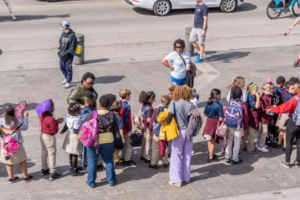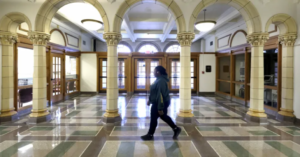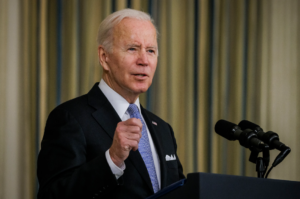NYC schools served 96 million fewer meals to children amid the pandemic, new data show
6 min read
When Mayor Bill de Blasio shut down school buildings last year, the city quickly spun up a “grab-and-go” program that made take-home meals available to any family, an effort to prevent hunger and distribute meals that would have normally been served in schools.
Despite quickly scaling up, the number of meals distributed by schools plummeted when the pandemic hit and is still far short of normal levels. In the year since school buildings shut down, the education department distributed 60% fewer meals to children compared with the year before the pandemic hit, a difference of about 96 million meals, according to state data obtained by Chalkbeat.
Typically, the education department’s food program only serves children. But amid the pandemic the city began offering take-home meals to any child or adult who wanted them, no questions asked. Even so, the education department distributed about 44% fewer meals to children and adults combined over the past year than schools served their students in the year before the pandemic, according to city data. (The figures include meals distributed through the grab-and-go program in addition to those served to students attending school in person.)
Food experts generally said they were impressed with the scale of the city’s grab-and-go program and noted it has been a lifeline for some struggling families. The dip is not entirely surprising, given that caregivers have to travel to pick up meals instead of them being served in cafeterias, as most students have been learning remotely since the pandemic hit. Other emergency food programs have also helped replace meals that students would have otherwise eaten at school.
But some worry that families are still struggling with food access even as meals are widely available at every education department-run school building. Advocates argue the city should do more to advertise the program and knock down other barriers that may hamper access, such as inconvenient pickup times or a lack of variety at certain sites. As the program is set to continue this summer, a time when participation in school meals typically plummets, advocates say there is an opportunity to get the word out and help ensure families are fed as the effects of the pandemic may continue to reverberate.
“We know people need food and there were announcements, but not nearly enough,” said Liz Accles, executive director of Community Food Advocates, who said she has generally been impressed with the program. “Neighborhoods should be saturated with information.”
Hunger on the rise
It is difficult to know exactly how many meals children have missed, but food insecurity has increased during the pandemic, particularly among families of color. City officials say 1.6 million residents are currently food insecure, a 33% increase compared with before the pandemic. A poll last summer found as many as half of New York City parents have skipped or reduced meals.
Despite the need, one study found the city’s education department had a lower participation rate in its meals program than Chicago, Los Angeles, and Houston school systems did early in the pandemic — though its authors also note that higher infection rates in New York City at the time could have played a role. Still, as of this February, Los Angeles schools had served several million more meals than New York City schools, even though the district enrolls roughly 38% fewer students.
Some school meals may have been replaced by new or expanded programs. New York City has delivered 122 million meals through an emergency service for city residents who are unable to leave their homes, though the city doesn’t track how many went to households with children. Every family at a city-run school received $420 in food assistance for each child, as did students in private and charter schools if their school participates in the federal school lunch program. In addition, many parents received direct stimulus payments.
Yet there are signs that families who could benefit from the school food program don’t know about it.
On a recent Wednesday morning, a mom dropping off some paperwork at Brooklyn’s P.S. 92 picked up two meals for her 11-year-old daughter when she noticed the food being distributed just inside the front entrance.
It was her first visit to the building since the pandemic hit.
“I didn’t know about it until today,” said the mom, who asked that her name be withheld. “I saw two simple meals and thought, ‘I could use that.’”
The city has taken some steps to get the word out about the program through text messages, displays on digital kiosks around the city, and banners outside schools, though at least one location in Brooklyn had no advertising outside.
“In coordination with the Department of Sanitation, our heroic food service employees were a critical part in preventing widespread hunger by making meals both safe and accessible for all, which was amplified by a public messaging campaign,” education department spokesperson Nathaniel Styer said in a statement. Styer indicated the advertising budget had “shifted” during the pandemic, but would not say whether it was cut.
Asked about information for families who don’t speak English, officials pointed to a city website whose default is English but includes a Google Translate feature and said signage was available to schools in other languages.
Communication, however, may not be the only barrier.
The window to pick up food for families is between 9 a.m. and noon, a challenge for those who work traditional hours or must supervise remote instruction. (Members of the general public can pick up meals from 3-5 p.m. at over 250 sites across the city.) And parents have offered mixed reviews about the variety of the food offerings, which are not consistent across all locations.
P.S. 92 parent Kelly Fleurimond has used the program a handful of times, and his daughter loves the reheatable pizza. (The breakfast pancakes, not so much.)
“I think it’s a good program,” Fleurimond said. “When I come here I get it, but it’s not something that I come for.”
One Manhattan mom said she was eager to participate in the program early in the pandemic but found the most common offerings — hummus or egg salad — repetitive and difficult to get her two children to eat.
“That’s why I don’t go there every day because it’s always the same meal,” said Jan, who asked that her last name be withheld.
To help make the school food program more appealing, the city began expanding its options beyond sandwiches and other cold offerings last summer to include frozen meals that are reheated at home, such as pizza, burgers, burritos, and grilled cheese sandwiches.
But not all schools appear to offer the frozen meals: In the roughly 20 times Jan has visited nearby grab-and-go sites, she has yet to see the reheatable meals available. An education department spokesperson could not say how widely available the reheatable meals are at sites across the city.
Gearing up for summer
The uptake on school meals might have been affected by some of the same factors that cause participation in summer meals to drop, ranging from lack of information about meal sites to stigma. It can be embarrassing to show up for free meals or intimidating to show up to an unfamiliar school, said Kathryn Hill, a researcher with the Research Alliance for New York City Schools at NYU, who has previously conducted focus groups with local families about the summer meals program.
As New York City is planning to continue its current food program throughout the summer, Hill said offering more sites such as libraries and parks could help drive participation, especially as the flexibility in federal rules allow families, including adults, to take food home. (Previously, the summer school food rules required that only students can eat the food, and they must do so in the same location in which it’s served.)
“A lot of the parents said that they found out about the meal program during the summer because they happened to be at a pool or a park where it was happening,” said Hill. “Getting more of these sites out into the community would probably be helpful.”
Other observers pointed to ways the city could build on elements of the program that families like while tweaking the type of food that is distributed.
David Rubel, a consultant who has studied the city’s grab-and-go program, said the city should work to make the food as enticing as possible, ensuring reheatable meals are widespread, and even experiment with providing families boxes of produce and other ingredients to cook with at home, something a few other districts have tried.
“This program is of huge significance and will continue throughout the summer,” Rubel said. “If the parent doesn’t have to spend $10, $15 a day on meals, that’s [money] that can go to something else.”
This article was originally posted on NYC schools served 96 million fewer meals to children amid the pandemic, new data show







